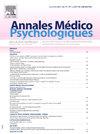各种形式的悲伤对边缘性人格障碍症状的影响
IF 0.5
4区 医学
Q4 PSYCHIATRY
引用次数: 0
摘要
痛苦烦躁情绪是边缘型人格障碍(BPD)患者现象学的重要组成部分。先前的研究已经将这种焦虑与重度抑郁症区分开来,强调了它的关系性、敌意性和无差别性。我们之前已经注意到,在BPD个体讨论充满悲伤的互动时,失去的处理是缺失的,并且较低水平的悲伤心理化与BPD特征密切相关。目的:我们希望通过根据不同性质的悲伤,或者换句话说,不同程度的悲伤心理化来定义烦躁的定义,从而继续探索BPD中痛苦抑郁的影响。我们将BPD定义为同时表现出高水平的不良心理悲伤和低水平的良好心理悲伤。换句话说,在心理等效水平上更大的精神痛苦体验,加上缺乏心理化或心理化的悲伤(或缺乏适应性悲伤,或哀悼的能力)。方法为验证这一假设,208名大学生(平均年龄22.4岁,女性占87.5%)完成了两份在线问卷:悲伤问卷(FSQ)和McLean BPD筛查量表(MSI-BPD)。FSQ评估悲伤的两种形式/质量或心理化水平:病理性悲伤(这里是自我批判的悲伤)和适应性悲伤(这里是可容忍的悲伤)。进行相关性和层次回归分析。结果自我报告的BPD标准数量与自我批判悲伤(病理性悲伤或较少精神化悲伤:r = 0.51**,大效应量)的相关性更强,与可容忍悲伤(适应性悲伤或精神化悲伤:r = -0.35 **,中等效应量)的相关性更弱。为了评估病理性和适应性悲伤对BPD特征预测的独特贡献,我们计算了层次回归分析,而不是性别和年龄等潜在混淆变量的贡献。结果表明,两种形式的悲伤,以及年龄,预测自我报告的BPD特征。最有力的预测因素是病理性的,或者说是较少精神化的悲伤。结论:研究结果间接表明,BPD焦虑症至少由两种类型的主观“抑郁”或焦虑体验组成:主要是一种主观通过感知难以忍受的精神疼痛形式来识别的痛苦或悲伤;而且,缺乏一种主观上可以忍受的悲伤,感觉很有成效。由于适应性悲伤有助于BPD特征,而病理性悲伤的贡献在统计上被剔除,研究结果表明适应性悲伤不能简化为病理性悲伤,它不仅仅是病理性悲伤的逆转或缺乏。当这两种形式的悲伤都被认为至少有点烦躁不安(都涉及到“强烈的悲伤”)时,这一观察结果就更加重要了,这加强了悲伤可以是一种适应性的想法,尽管非常痛苦。这些结果的临床意义可能是,对经历BPD症状的个体进行心理治疗的目的不仅是减少痛苦,而且要培养一种忍受悲伤的能力,以便“更好地忍受”和哀悼人际关系的损失。本文章由计算机程序翻译,如有差异,请以英文原文为准。
Contribution des formes de tristesse aux symptômes du trouble de personnalité borderline
Painful dysphoric affects are an important part of the phenomenology of individuals suffering from borderline personality disorder (BPD). Previous research has distinguished this dysphoria from major depression, underlining its relational, hostility-laden, and undifferentiated nature. We have previously noted that the processing of loss was absent from BPD individuals’ discussion of sadness-laden interactions and that lower levels of mentalization of sadness were strongly associated with BPD traits.
Objectives
We wish to pursue our exploration of painful depressive affects in BPD by framing the definition of dysphoria in terms of differing qualities of sadness or, in other words, differing levels of mentalization of sadness. We conceptualize BPD as presenting both high levels of poorly mentalized sadness and low levels of well-mentalized sadness. Stated differently, a greater experience of psychic pain at a psychic equivalence level, combined with a lack of mentalized or mentalizing sadness (or a lack of adaptive sadness, or the capacity to mourn).
Method
To test this hypothesis, 208 undergraduate students (mean age: 22.4; 87.5% female) completed two online questionnaires: the Forms of Sadness Questionnaire (FSQ) and the McLean Screening Instrument for BPD (MSI-BPD). The FSQ assesses two forms/qualities, or levels of mentalization, of sadness: pathological sadness (here, self-critical sadness) and adaptive sadness (here, tolerated sadness). Correlations and hierarchical regression analysis were conducted.
Results
Correlations indicate that the number of self-reported BPD criteria is more strongly associated with self-critical sadness (pathological or less mentalized sadness: r = 0.51**, large effect size) and also, but less strongly, with tolerated sadness (adaptive or mentalized sadness: r = –0.35**, medium effect size). A hierarchical regression analysis was computed in order to assess the unique contribution of pathological and adaptive sadness on the prediction of BPD traits, over and above the contribution of the potential confounding variables of sex and age. Results indicate that both forms of sadness, as well as age, predict self-reported BPD traits. The strongest predictor is pathological, or less mentalized, sadness.
Conclusions
The findings give an indirect indication that BPD dysphoria is composed of at least two types of subjective “depressive” or dysphoric experiences: mostly a type of suffering or sadness that is subjectively recognized through the perception of difficult to tolerate forms of mental pain; and also, a lack of a form of subjectively tolerable sadness, felt as productive. Since adaptive sadness contributes to BPD traits while the contribution of pathological sadness is statistically removed, the findings indicate that adaptive sadness is not reducible to pathological sadness, that it is not simply the reverse or absence of pathological sadness. This observation is even more significant when it is underscored that both forms of sadness are felt as at least somewhat dysphoric (both involve feeling “intense sadness”), reinforcing the idea that sadness can be an adaptative, although quite painful, experience. A clinical implication of these results might be that psychotherapy for individuals experiencing BPD symptoms should aim not only to reduce distress but also to cultivate a capacity to tolerate sadness in order to “suffer better” and mourn interpersonal losses.
求助全文
通过发布文献求助,成功后即可免费获取论文全文。
去求助
来源期刊

Annales medico-psychologiques
医学-精神病学
CiteScore
1.30
自引率
33.30%
发文量
196
审稿时长
4-8 weeks
期刊介绍:
The Annales Médico-Psychologiques is a peer-reviewed medical journal covering the field of psychiatry. Articles are published in French or in English. The journal was established in 1843 and is published by Elsevier on behalf of the Société Médico-Psychologique.
The journal publishes 10 times a year original articles covering biological, genetic, psychological, forensic and cultural issues relevant to the diagnosis and treatment of mental illness, as well as peer reviewed articles that have been presented and discussed during meetings of the Société Médico-Psychologique.To report on the major currents of thought of contemporary psychiatry, and to publish clinical and biological research of international standard, these are the aims of the Annales Médico-Psychologiques.
 求助内容:
求助内容: 应助结果提醒方式:
应助结果提醒方式:


